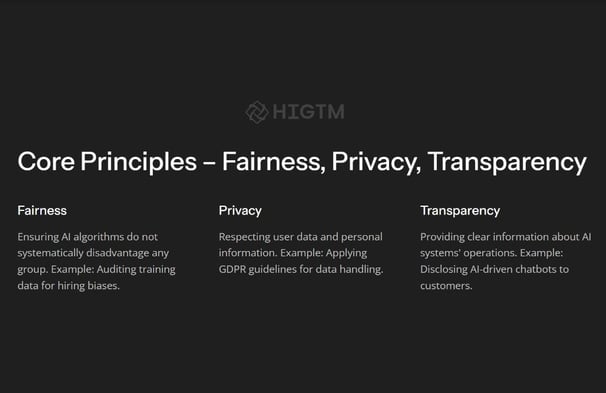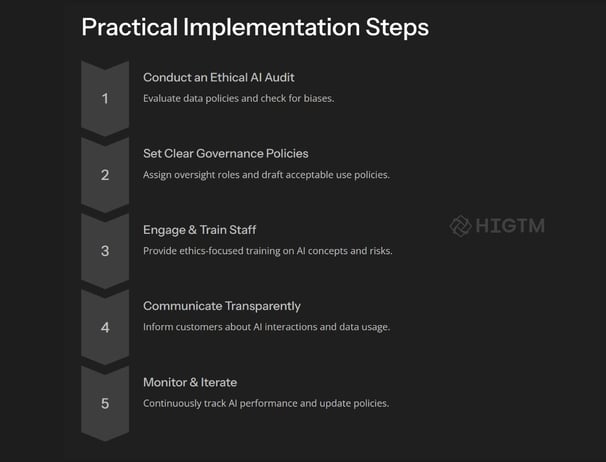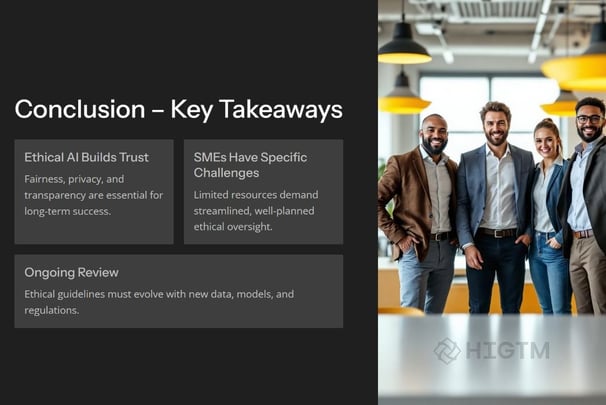18. Ensuring Fairness, Privacy, and Transparency: How SMEs Can Embed AI Ethics into Their Business Operations
Along with AI’s potential to streamline operations and fuel growth comes a set of ethical responsibilities. AI ethics is not just for global tech giants—SMEs also face critical questions about fairness, privacy, and transparency. This long-form article explores why AI ethics matter, how to embed ethical principles in your SME’s practices, and the tangible steps you can take to maintain customer trust and protect your brand reputation.
Q1: FOUNDATIONS OF AI IN SME MANAGEMENT - CHAPTER 1 (DAYS 1–31): CORE AI CONCEPTS & VALUE PROPOSITION
Gary Stoyanov PhD
1/18/20255 min read

1. Why AI Ethics Matter for SMEs
Trust and Credibility: In crowded markets, consumers gravitate toward companies that handle personal data responsibly and treat users fairly. Upholding ethical AI principles can become a competitive differentiator.
Regulatory Compliance: Data protection regulations such as the General Data Protection Regulation (GDPR) in Europe or the California Consumer Privacy Act (CCPA) in the U.S. can apply to smaller firms with international customers or online presence. Noncompliance may lead to fines and reputational damage.
Long-Term Sustainability: Cutting corners on ethics might yield short-term gains but can erode employee morale and customer loyalty over time, ultimately undermining your business stability.
Key Point: SMEs often have fewer resources to handle lawsuits or PR crises, making proactive ethical planning even more critical.
2. Breaking Down AI Ethics: Fairness, Privacy, and Transparency
2.1 Fairness
Definition: Avoiding decisions or outcomes that unjustly disadvantage individuals or groups, especially those defined by race, gender, age, or other protected characteristics.
Data Bias: AI models learn from historical data, which can contain biases. For instance, a hiring algorithm might undervalue candidates from certain backgrounds if the training dataset lacks diversity.
Unintentional Exclusion: Business processes driven by biased algorithms may overlook minority customer segments, causing unintentional discrimination in financial services, healthcare recommendations, or retail promotions.
Practical Tip: Conduct a bias audit by testing model outcomes on various demographic groups. If you spot disparities, either retrain with more diverse data or adjust the algorithm to account for underrepresented categories.
2.2 Privacy
Definition: The right of individuals to control their personal information and understand how organizations collect, use, and store it.
Data Minimization: Collect only the data necessary for a specific purpose. Avoid storing large, unstructured data sets “just in case.”
Consent & Control: Inform customers about data collection and give them control over what is shared.
Secure Storage: Use encryption and robust access control to protect against unauthorized data access or breaches.
Practical Tip: Map out your data lifecycle—from acquisition to deletion. Implement GDPR-like privacy standards by default, regardless of your location, to reassure customers that you respect their personal data.
2.3 Transparency
Definition: Openness about when and how AI is used, as well as clarity regarding why certain decisions are made.
Clear Disclosure: If a chatbot is AI-driven, let users know they’re interacting with a machine.
Explainable AI: Provide understandable explanations for algorithmic decisions, especially those with substantial impact (e.g., loan approvals, job candidate filtering).
Internal Transparency: Ensure your employees also understand AI-driven processes. This clarity fosters acceptance and reduces fear of the unknown.
Practical Tip: Draft plain-language summaries of how your AI tools operate—what data they use and the logic behind them. Post these on your website or internal knowledge base to foster trust internally and externally.
3. Ethical Pitfalls for SMEs and How to Avoid Them
Biased Models from Limited Datasets: Smaller companies might have restricted data sets, increasing the risk of unrepresentative samples.
Over-Collection of Data: Some SMEs over-gather data without a concrete plan, exposing themselves to legal and security risks.
Black-Box Decision-Making: Quick adoption of complex AI platforms can lead to outcomes that even the developers do not fully understand, hindering transparency.
Neglecting Human Oversight: AI is not infallible; final judgments often need human review to catch subtle issues or cultural nuances.
Recommendation: Engage in a pilot testing phase. Monitor results across different groups or scenarios and tweak data inputs or algorithm parameters to mitigate unforeseen biases.
4. Implementing Ethical AI: Step-by-Step
4.1 Ethical AI Audit
Data Review: Examine existing data sets for completeness and diversity. Remove or mitigate biased elements.
Model Audits: Use open-source libraries or partner with consultants to scan for algorithmic biases.
Policy & Governance: Establish guidelines on acceptable AI uses, data handling, and dispute resolution.
4.2 Training and Capacity Building
Workforce Upskilling: Train employees—especially developers, marketers, and decision-makers—on the basics of AI, potential biases, and privacy laws.
Ethics Committees: Form a small cross-functional team that periodically reviews AI projects from an ethical standpoint.
Consulting Partnerships: If in-house resources are limited, external specialists can fill the gap with tailored assessments and ongoing support.
4.3 Communication and Transparency
Customer-Facing Disclosures: Clearly label AI-driven applications, like chatbots or recommendation engines, on your public-facing websites.
Feedback Mechanisms: Invite customer feedback and provide channels for users to correct their data or contest AI-driven decisions.
Employee Engagement: Encourage staff to raise ethical concerns and propose improvements.
4.4 Monitoring and Iteration
Data Drift Analysis: Real-world data can shift over time, causing models to degrade or reintroduce bias. Schedule regular recalibration.
Incident Response Plans: Develop protocols for data breaches or algorithmic errors, clarifying who responds and how.
Performance Metrics: Track key indicators for fairness (e.g., error rates across demographics) and privacy (e.g., compliance with data retention policies).
5. Navigating AI Regulations and Standards
GDPR (General Data Protection Regulation): Enforced by the EU, mandates data privacy and user consent. Even SMEs outside Europe may need to comply if handling EU data.
CCPA (California Consumer Privacy Act): Grants consumers more control over personal information, affecting businesses that serve California residents.
ISO Standards (e.g., ISO/IEC 27001): While not specifically AI-focused, these can help structure robust data security practices.
Key Point: Proactive compliance is often less costly than retroactive fixes. Build ethics into your AI deployment from the start, rather than waiting for legal pressures or negative headlines.
6. The Business Case for Ethical AI in SMEs
Customer Loyalty and Brand Image: Ethical AI fosters goodwill, helping SMEs stand out amid larger competitors.
Risk Mitigation: Transparent data handling and unbiased algorithms reduce litigation and regulatory penalties.
Talent Attraction: Employees, especially younger professionals, increasingly seek companies that match their values—an ethically responsible stance on AI can be a draw.
Strategic Advantage: Insightful, ethical AI usage leads to better decision-making and, ultimately, long-term profitability.
7. Case Studies: SMEs Championing AI Ethics
7.1 Ethical E-Commerce Startup
Issue: Potential product recommendation bias favoring higher-margin items.
Action: Conducted monthly model audits to ensure recommendations balanced profitability with user interest.
Result: Transparency about fairness metrics built trust, increasing repeat customer purchases by 15%.
7.2 Boutique Marketing Agency
Issue: Using AI-based audience segmentation, fear of discriminatory advertising.
Action: Implemented a policy requiring explicit human sign-off for campaigns targeting specific demographics.
Result: Maintained compliance with advertising regulations while earning positive feedback for inclusive messaging.
8. Overcoming Organizational Resistance
Executive Alignment: Present a clear ROI for ethical AI—such as safeguarding brand reputation or reducing compliance costs—to leadership.
Employee Buy-In: Involve staff early. Demonstrate that ethical AI can reduce mundane tasks and let them focus on creative or strategic work.
Cultural Shift: Celebrate small successes, like detecting a potential bias in a pilot test. Publicly recognizing these efforts shows the organization values responsible innovation.




10. Conclusion: Charting a Responsible Path Forward
Small and medium-sized enterprises might not have the same resources as global corporations, but that doesn’t reduce their ethical obligations. By embracing fairness, privacy, and transparency, SMEs position themselves as trustworthy stewards of AI. This ethical foundation not only fulfills legal and societal expectations but also fuels deeper customer loyalty and sustainable growth.
Fairness ensures no group is arbitrarily sidelined.
Privacy respects individuals and builds confidence in your services.
Transparency demystifies AI and invites stakeholder collaboration.
When incorporated thoughtfully, these pillars act as cornerstones of ethical AI in SMEs, proving that responsible innovation is well within reach.
If you’re ready to take the next step in ethical AI adoption—whether that’s auditing your existing data practices, refining your algorithms for fairness, or bolstering transparency measures—our team at HIGTM is here to support you.
Schedule a Private Ethics Consultation with us and let’s develop an AI framework that upholds your values while driving measurable success.
9. Future-Proofing Your SME’s AI Strategy
AI ethics isn’t static; as new technologies emerge (e.g., advanced language models, facial recognition), you’ll need to reassess the ethical implications continuously. Future-proofing requires:
Continual Education on emerging ethical standards.
Adaptive Governance structures that can respond to new data types and AI functionalities.
Scalable Infrastructure that can incorporate ethics checks into each stage of AI’s lifecycle, from model design to deployment and feedback loops.


Turn AI into ROI — Win Faster with HIGTM.
Consult with us to discuss how to manage and grow your business operations with AI.
© 2025 HIGTM. All rights reserved.
